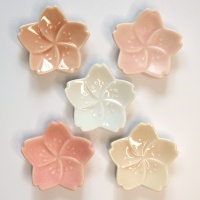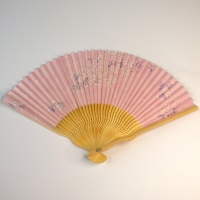Early spring is a really beautiful time to visit Japan so that you can see cherry blossom and experience the joy of 'hanami'. But did you know that in Japan each year there is a ‘sakura forecast’ to predict the pattern of cherry trees blossoming across the country?
The sakura forecast (桜前線, sakura zensen) is Japan’s annual cherry blossom forecast, predicting when the cherry blossoms will start blooming across different regions.
*

It’s a big deal in Japan because ‘hanami’ (flower-viewing) season is a celebrated tradition and people plan gatherings, picnics and even travel around it. The origins of this forecast are interesting and show the cultural importance of cherry blossom, or ‘sakura’, to Japanese people.
*
How is the sakura forecast made?
The forecast is based on the blooming patterns of the Somei Yoshino cherry tree which is the most common sakura variety in Japan. Meteorologist take various data into account and use a combination of:
- Temperature data;
- Historical bloom records;
- Current climate conditions and
- Tree health and local weather changes
Because cherry blossoms bloom in response to warming temperatures, they start in the south from Okinawa and Kyushu and move northward towards Hokkaido like a wave. This is why it’s called a zensen, which means ‘front’, similar to a weather front.

Not only does the forecast give the initial timings for the trees to blossom but it also gives a schedule for the various stages of the blossoms as these too are affected by climate and local weather conditions.
The stages of sakura flowers are:
- Kaika (開花) – First blossoms open
- Mankai (満開) – Full bloom - best time for hanami!
- Sakurafubuki (桜吹雪) – Petals begin falling like pink snow

Originally, the Japan Meteorological Agency (JMA) used to be the main source of the forecast but now private weather companies like Weathernews, WeatherMap and Japan Meteorological Corporation also provide detailed forecasts which include the expected peak bloom dates for major locations.
Some typical regional timings for seeing cherry blossom in Japan are:
- Okinawa: January – February
- Kyushu/Shikoku: Late March
- Kansai/Kanto (Osaka, Kyoto, Tokyo): Late March – early April
- Tohoku: Mid-April
- Hokkaido: Late April – early May
The exact timing changes each year due to climate conditions and hence the need for an annual forecast.
In recent years, warming trends have led to the blooms coming earlier in the season. For example, in 2025 the first cherry blossom blooms in Okinawa were observed on 5 January in Naha, the prefectural capital. This was 11 days earlier than average and eight days earlier than 2024.
The effect of a warming planet on Japan’s sakura season
It’s true to say that climate change has been observed to affect the timing of the sakura season in Japan. Historical records, especially from Kyoto, indicate that cherry blossoms are blooming earlier than in previous centuries. In 2021, Kyoto experienced its earliest peak bloom in over 1,200 years, a phenomenon attributed to rising global temperatures and urbanization.
Studies have shown that the combined effects of global warming and urban heat islands have advanced the ‘peak bloom’ period by approximately 11 days.

This trend has implications not only for Japan's cultural traditions such as Hanami celebrations but also for ecosystems and tourism. As the climate continues to warm, the timing of natural events like cherry blossom blooming is expected to shift further, demonstrating the pervasive impact of climate change on both natural and cultural phenomena.
And aside from gradually warming temperatures, the rise in extreme weather events such as sudden unseasonal frosts or typhoons could damage trees and blossoms, affecting species that depend on them.
In Japan, several bird and insect species, for example, have a close symbiotic relationship with cherry trees and these seasonal changes could be affecting them as well.
The impact on birds

Some birds, including crows, eat sakura buds before they fully bloom and another common bird, the Brown-eared Bulbul (ヒヨドリ, Hiyodori in Japanese), feeds on both cherry blossoms and the insects that gather on them. Changes in bloom timing could affect the food sources for these species.
The Japanese White-Eye (メジロ, Mejiro) is one of the most famous visitors to cherry blossoms. They feed on the nectar of sakura flowers and help with pollination. If the trees bloom earlier than usual, there’s a risk that the migration or breeding patterns of these small green birds may not align with peak flowering.
Impact on the insect world

Bees rely on sakura nectar as an early spring food source. If cherry trees bloom too early due to warm winters and bees are still in hibernation or not yet active, pollination could be reduced.
The Sakura Leaf Beetle (サクラハムシ, Sakurahamushi) depends on cherry trees for food and reproduction. If the trees bloom and grow leaves earlier then the lifecycle of this small beetle may become misaligned.
Butterfly and moth species also lay eggs on cherry trees and caterpillars feed on the leaves. If trees bloom too early or too late, it could affect their survival.
How did the sakura forecast begin and why?
The history of the sakura forecast isinteresting as it reflects Japan’s cultural traditions and the nation’s postwar modernization.
The Japan Meteorological Agency began officially tracking cherry blossom blooming patterns in 1951 and the main reason was to help the public plan for hanami (flower-viewing) gatherings, a tradition that dates back centuries.
The forecast also became useful, however, for tourism and agriculture as blooming times signalled the transition to spring.

After World War II, as part of Japan’s postwar recovery, infrastructure improved and radio and television broadcasts became widespread. Meteorologists began using temperature data to predict the timing of sakura season, enabling people to get accurate information for planning events.
With hanami celebrations being a major seasonal event, businesses like department stores, food vendors and travel agencies could benefit from knowing the forecast in advance.

From the 1950s through to the 1980s, the JMA dominated forecasting, using long-term records and temperature data.
From the 1990s private weather companies, like Weathernews and Japan Weather Association started making independent predictions. Today, technology and climate models have improved in accuracy and forecasts now use AI, satellite data and even crowd-sourced reports from the public.
*
As you can see, the sakura forecast has become as much a part of Japanese culture as the hanami viewing parties and symbolic meaning of sakura itself to Japanese people. If you are visiting Japan, it's also helpful for planning your trip to make sure you see this Japanese phenomenon for yourself.
Although records of cherry blossom blooming have been kept for centuries in Japan, this modern forecast makes use of the latest technology to provide accurate and useful information, enabling Japanese people to celebrate their culture in the most beautiful way!
A haiku for the sakura forecast
Blossoms ride the breeze,
Whispers of spring’s gentle call,
Forecast paints the skies









